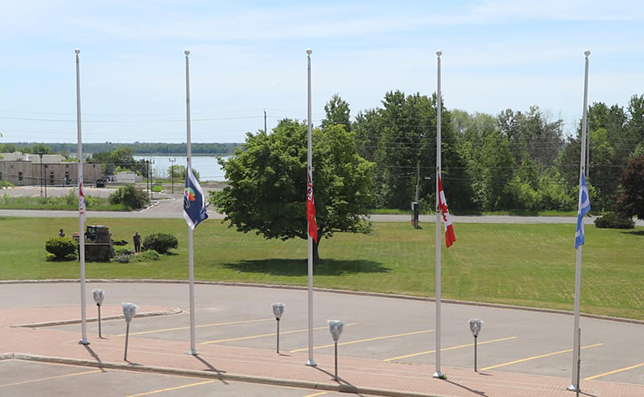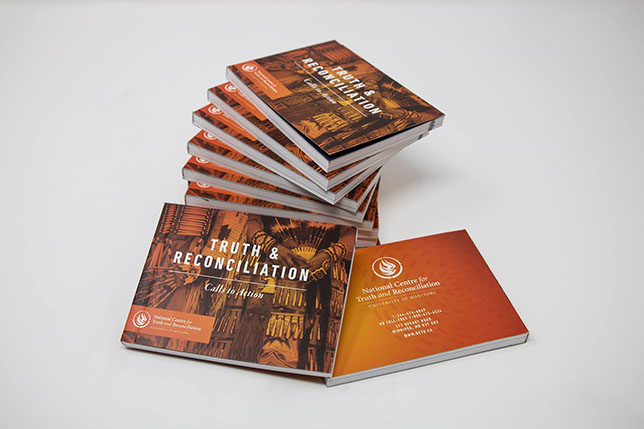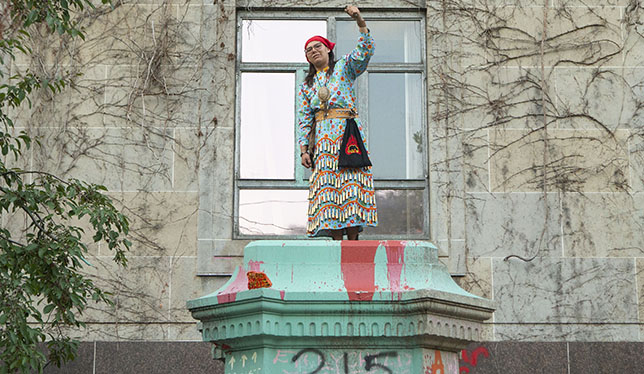When Asima Vezina learned the remains of 215 Indigenous children had been discovered in unmarked graves at a former residential school in Kamloops, B.C., it set in motion a chain of events at her own educational institution thousands of kilometres away.
As president and vice-chancellor of Algoma University in Sault Ste. Marie, Ms. Vezina decided the first step was to seek guidance from survivors in her community.
“We needed to come together, and we did, in ceremony and prayer,” she recalls. This led to a joint statement from the university and several local Indigenous organizations: “Miigwetch [thank you] to those young Spirits for bringing themselves to our attention, they are telling us about the work we need to do,” it began.
Another statement was issued the next day, announcing a search would be conducted “to address the potential that there may be burial sites outside the marked gravesites” on Algoma’s main campus, which itself was a residential school until 1970. Ms. Vezina says care will be taken to do the work “in a respectful, culturally appropriate way.”
The university’s response speaks to the close relationship that has taken root between Algoma’s senior leadership and groups such as the Children of Shingwauk Alumni Association (CSAA), which is made up of residential school survivors and their descendants. “We’ve had our share of disagreements in hard times – but recently we’ve really flourished,” says Jay Jones, president of the association and a member of the Walpole Island First Nation. “They’ve listened to the elders, and we’ve moved forward in such a fantastic way, where everyone’s benefiting.”
As Ms. Vezina puts it: “They have really taken us under their wing.”

The provincial and federal governments have taken notice of what’s happening at Algoma, announcing $13 million in funding this spring to establish a cross-cultural centre. It will highlight the work of the CSAA, which was established more than 20 years ago. The centre will also serve as the new home of the Shingwauk Residential Schools Centre, an education and research facility currently housed in the main building on campus that includes an archive on residential and day schools from coast to coast. In July, Parks Canada also recognized the former Shingwauk residential school as a national historic site.
Those are a few ways the promise of truth and reconciliation is playing out at one university. As Canadians try to come to terms with the residential school system’s impact on Indigenous peoples, University Affairs spoke with Indigenous officials, scholars and allies in several provinces to gauge the progress being made in universities across the country.
A cultural shift
“It is really important to celebrate, in institutional forums, the gains that have been made and the work that still needs to be done,” says Marlene Brant Castellano, a professor emeritus at Trent University who is recognized internationally as a trailblazer in the field of Indigenous studies. When she started out as a student at Queen’s University more than half a century ago, she was the only Indigenous student. Last year there were 456, plus 100 Indigenous staff and faculty.
“There have been huge changes in programs, in curriculum, in policy, in appointments, in the numbers and the presence of tens of thousands of Indigenous students, studying to take their place in boardrooms and policy circles and public services,” says Dr. Brant Castellano, a Mohawk of the Bay of Quinte.
The number of Indigenous scholars that have been named to senior administrative positions in recent years is a sign of a cultural shift underway at many postsecondary institutions, she says.
One of them is Ry Moran, a member of the Red River Métis. He’s the inaugural associate university librarian, reconciliation, at the University of Victoria, former director of the six-year-old National Centre for Truth and Reconciliation and former director of statement gathering with the Truth and Reconciliation Commission of Canada (TRC).
“We know that anti-Indigenous racism is different, and we know that it’s rooted in legislation.”
“The question of Indigenous peoples having a voice in how education systems are developed and rolled out is one of the most long-standing
sources of advocacy, activism and super hard work from a lot of Indigenous peoples,” Mr. Moran says. “The TRC was just another clear affirmation that the time for change is now, and that what we’re seeking isn’t incremental change.”
The commission, headed by Justice Murray Sinclair, issued its final report in 2015. It included 94 calls to action, some of which apply directly to higher education. For example, number 16 urges postsecondary institutions to create degree and diploma programs in Indigenous languages.
Number 57 calls in part for public servants to be educated on the history of Indigenous peoples, including the legacy of residential schools, and urges “training in intercultural competency, conflict resolution, human rights and anti-racism.” And number 62 encourages the federal government to “provide the necessary funding to post-secondary institutions to educate teachers on how to integrate Indigenous knowledge and teaching methods into classrooms.”
But Mr. Moran says the calls to action need to be considered alongside the commission’s 10 principles of reconciliation as well as the United Nations Declaration on the Rights of Indigenous Peoples (UNDRIP), which the commission called on all levels of government to implement. “It’s those three things that come together and really help us have a much more robust and full understanding of what the transformative work is that needs to occur,” he says.

Article 43 of UNDRIP states the rights it recognizes “constitute the minimum standards for the survival, dignity and well-being of the Indigenous peoples of the world,” while article 15 asserts that Indigenous cultures, traditions, histories and aspirations “shall be appropriately reflected in education and public information.” Operations at UVic libraries are now looked at through the lens of UNDRIP, Mr. Moran says.
At the University of Manitoba, which is home to the National Centre for Truth and Reconciliation, work is underway to track what each faculty and department is doing on the issue. Officials are also developing an institution-wide anti-racism strategy, including a component devoted specifically to anti-Indigenous racism.
“We’ve been looking nationally, and talking to our colleagues nationally, and realizing that there has not been a lot of work done in the area,” says Christine Cyr, associate vice-president, Indigenous, who is working on that part of the project. “We know that anti-Indigenous racism is different, and we know that it’s rooted in legislation.”
Read also: Weaving Indigenous and western knowledge
Everyone involved in the project took part in a virtual ceremony over two days and “were guided through a visioning session by an Indigenous knowledge keeper,” says Ms. Cyr, who is Métis. The project is being headed by a non-Indigenous person so that Indigenous members don’t have to do the “heavy lifting.” The goal is for other institutions to use their work as a model. “Ultimately we hope that there will be no need for the policy — but for today, we absolutely do need it,” she says.
Since 2015, the Canadian university community has met annually for the Building Reconciliation Forum. After a forced pause in 2020 due to the pandemic, the sixth forum will be hosted by Université Laval and Université du Québec this September on the theme of “Falling into step with First Peoples students.” According to Nadine Gros-Louis, government relations counsellor with the First Nations Education Council and a member of the governance committee for the event, the theme is intended to initiate “meaningful and lasting changes … in the higher education community to help advance reconciliation.”
“There’s definitely an openness at universities to integrating the realities of First Peoples into institutions in terms of decolonization of their approaches or Indigenization of content,” notes Ms. Gros-Louis, who believes that Quebec universities have been more attentive to these issues in the last two years. As an example, she cites the many university action plans aligned with the reconciliation movement.
The forum, being held in Eastern Canada for the first time, will welcome 11 ambassadors — students or graduates representing Indigenous nations in Quebec. “They’ve also participated in proposing ideas for solutions and engagement with universities,” Ms. Gros-Louis explains. “It’s very important to hear from those who are directly affected by the university community, because they’re the ones who live in that environment every day.”
Access and inclusion
The Assembly of First Nations put out a report card on nationwide truth and reconciliation efforts last December that touched on the postsecondary sector. It said some progress has been made in offering Indigenous legal education and singled out a new program at UVic that offers a joint degree in common law and Indigenous legal orders. But the report also noted there is “a persistent backlog of First Nations students seeking a postsecondary education” across the country due to a shortage of public funds.
Making university more accessible to Indigenous peoples also means ensuring the experience is inclusive. That’s something Lakehead University has been focusing on, says Cynthia Wesley-Esquimaux, who became the country’s first chair in truth and reconciliation there five years ago. “Obviously we want to make Lakehead a destination for education, and to do that for Indigenous peoples, we have to be clear we’re offering programming that actually meets their needs,” she says.
“Anytime something Indigenous comes up, all eyes turn to the one or two faculty members who are expected to speak for all other Indigenous people in the country and they simply cannot do that.”
Resources are available to support students making the transition from remote communities. Daycare spaces are set aside for Indigenous students arriving with children. And there is help on offer to find living accommodations since “it’s really hard for Indigenous students to rent places in Thunder Bay because of the racism,” says Dr. Wesley-Esquimaux, who is a member of the Chippewa of Georgina Island First Nation.
In 2016, the university also made it mandatory for all students to complete at least one course that contains a minimum of 50 per cent Indigenous content. The result is a growing number of students who self-identify as Indigenous, nearing 14 per cent of the university’s overall enrollment. Despite such gains, there is still a long way to go to achieve fundamental change, says Shelly Johnson, the first Canada Research Chair in Indigenizing Higher Education, and an associate professor at Thompson Rivers University.
“We’re long on rhetoric and we’re long on basic low-hanging fruit. That is, how do we get more Indigenous people hired? How do we involve elders in a meaningful way? How do we provide more scholarships or bursaries to Indigenous students?” she says. “And really that’s where it ends, mostly, across the country.”
Only 1.4 per cent of faculty identified as Indigenous in the last federal census in 2016. Dr. Johnson says that can create unfair expectations and lead to retention problems. “Anytime something Indigenous comes up, all eyes turn to the one or two faculty members who are expected to speak for all other Indigenous people in the country and they simply cannot do that,” she says. “Or a lot of service committee work will happen, and everybody wants an Indigenous person to sit on their committee to give an ‘Indigenous perspective.’” Some institutions have been experimenting with cluster hires, bringing in several professors at a time so they have more support.
Another pressing issue has to do with relations between universities and local First Nations. “We’re not at the point where many institutions are saying, ‘All of the benefits of being on unceded or treaty territory accrues to the institution. What are we doing in terms of reciprocity, in giving back to those nations on whose unceded territory, or on whose lands we’re located?’” says Dr. Johnson, who is Saulteaux and a member of the Keeseekoose First Nation.
One step would be to give qualified candidates from those nations preference in hiring practices, she says. Another would be to appoint elders who are providing advice or student support on campus to full-time positions with benefits, rather than precarious part-time employment. A case in point is Vancouver Island University, which hired its first fulltime elder-in-residence eight years ago.
Guiding principle
Two academics at the University of Alberta recently studied what it means to indigenize the postsecondary sector. In a 2018 paper, Adam Gaudry and Danielle Lorenz imagine a three-part spectrum. On one end is the idea of inclusion, simply to boost the number of Indigenous people on campus. In the middle is reconciliation, which involves “creating a new, broader consensus on debates such as what counts as knowledge.” And on the far end is decolonization, which “fundamentally reorients knowledge production to a system based on different power relations between Indigenous peoples and Canadians.” While many colleges and universities use the language of reconciliation, the researchers concluded, most of their actions focus on inclusion. Yet decolonization efforts are what are needed to “demonstrate a way toward a more just Canadian academy,” they wrote.
Whether universities engage in deeper reforms depends on the willingness of administrators to work collaboratively, says Craig Fortier, an associate professor of social development studies who co-chairs the truth and reconciliation committee at the University of Waterloo’s Renison University College. “They have to be willing to vulnerably cede control of the process, and not make this about public relations, or some kind of fad that’s happening throughout universities, but rather, really be sincere that the process may require fundamental transformation of what they do,” he says. “They can’t control the process to have an outcome like tokenistic improvements that fit within the current model of the system.”
Read also: Archives are adapting to an era of digitization and decolonization
Dr. Fortier also says that recognizing the role non-Indigenous faculty like him need to play is vital. “At the end of the day, we can’t ask the very small amount of Indigenous people who are on our campus to load this massive burden on their backs, when it is our responsibility as non-Indigenous people to do that work. But we can’t do that work and control that work without having their leadership and guidance, and saying, ‘This is what feels like a good strategy toward decolonizing, or unsettling, or reconciling the university with its history, its actions and its current processes.’”
Several people interviewed for this article say UNDRIP could provide a pathway to fundamental change. The federal government committed to fully implementing the declaration five years ago. In June, Ottawa passed Bill C-15, which sets a two-year deadline to come up with a framework to do so.
There is activity at the provincial level too. British Columbia passed legislation to implement UNDRIP in 2019. It includes a key provision from the declaration – that governments consult and cooperate with Indigenous peoples in good faith to get their “free, prior and informed consent” on decisions that affect them. The legislation may provide a glimpse of things to come elsewhere in the country, says Mr. Moran at UVic.
“As additional provinces and territories begin to pass similar-type legislation, it will require universities broadly to begin to harmonize their policies and practices with that very fundamental human rights mechanism,” he says, “no different than we are expected to operate in accordance with multiple human rights acts and human rights codes across the country.”
How quickly and to what extent that will take place remains to be seen. But Dr. Brant Castellano of Trent is hopeful that public outrage over the cascading discoveries of unmarked graves at former residential schools will lend momentum.
“People who love their children and have some notion of what it is to have your child forcibly removed and disappear – the depth of the response from the public, Murray Sinclair and others think that maybe this is the tidewater, this is the turning of the tide to recovery.”
*With collaboration from Émile Bérubé-Lupien.

Thank you for this well written article. It speaks to the essential issues directly and with clarity. As a non-Indigenous scholar who has studied and worked in the discipline of Indigenous Studies for many years, I hope and pray that deep and meaningful change will continue to develop on university campuses across the country. It is long over due.
Ross Hoffman
Professor Emeritus
First Nations Studies
University of Northern British Columbia
Given that Canadian Medical Association Journal just published an article on vaccine hesitancy among people who are Indigenous and have a healthy distrust of government and the health care system, CAUT’s promotion of vaccine mandates for vaccines which have existed less than 18 months and for which there are no long-term effects data, seems to conflict with their purported support of Truth & Reconciliation. It also is in conflict with any true effort to achieve equity, diversity and inclusion, as it is segregation on the basis of failing to submit one’s body to what others think is best, with no regard for one’s individual health history, goals, values, prior traumas, let alone one’s inalienable human rights. Where are all those who sit on Human Research Ethics Boards as our universities make one’s employment or education contingent upon participating in clinical experimentation? These vaccines have not completed the full clinical trial process. There’s also that pesky fact that the Cominarty vaccine that has been approved by Pfizer is not available, while the one that remains available still is only approved for emergency use only. Are we all just a bunch of lying hypocrites who can’t be bothered to read the data and think critically about what is happening in response to Covid-19? It’s a fiasco rooted in bad interpretations of science, social science and public policy. Time to step up folks!